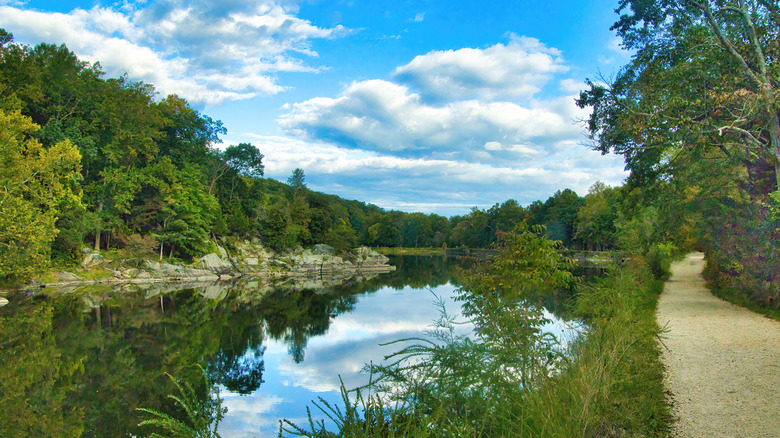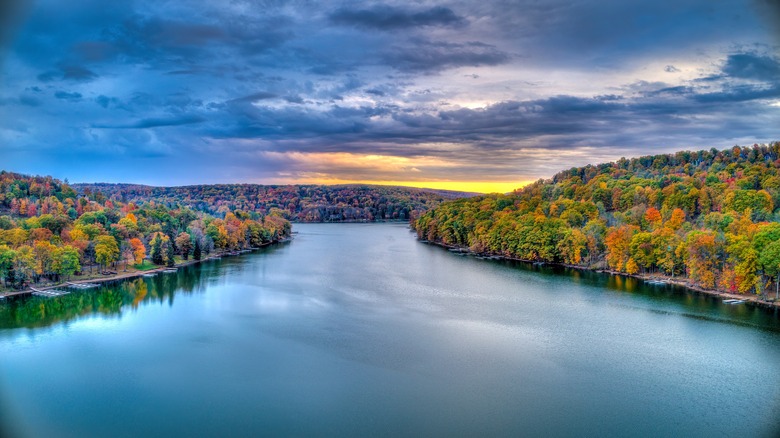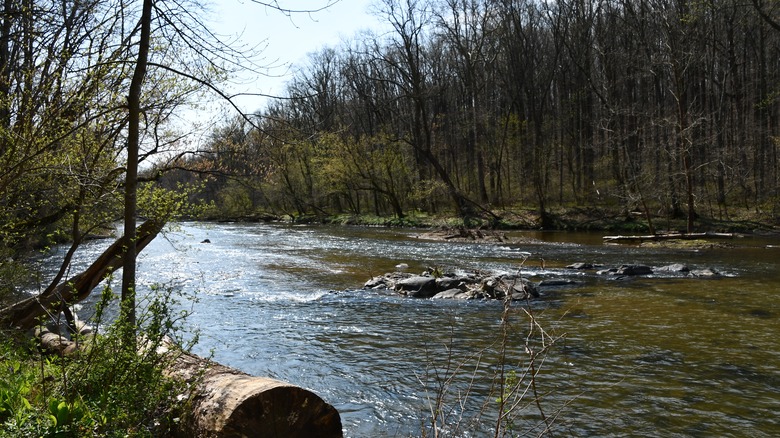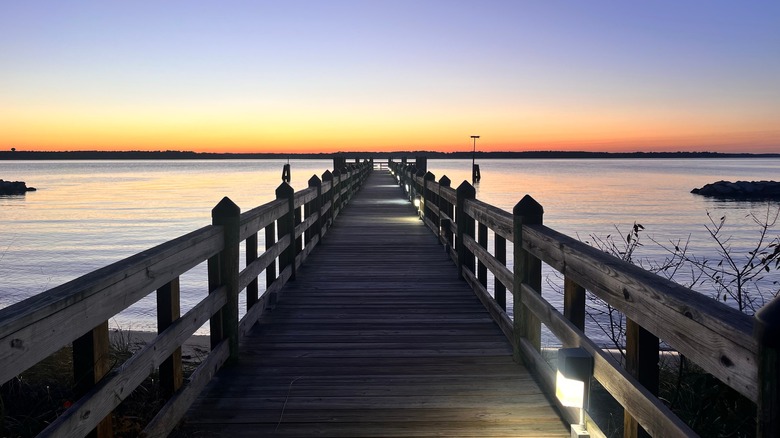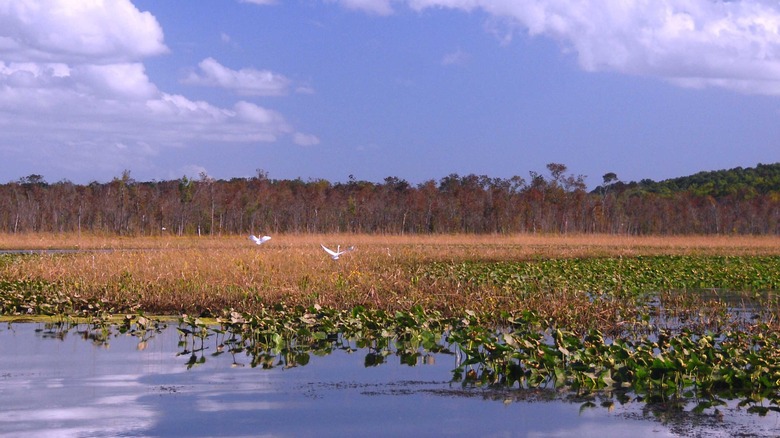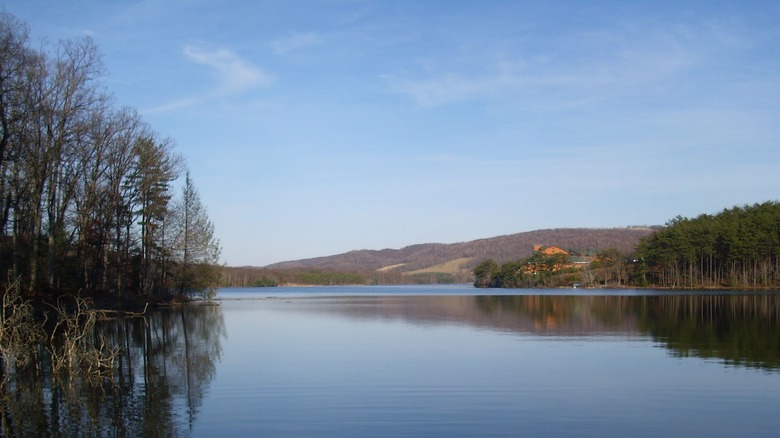You Might Want To Think Twice Before Dipping Into These Snake-Heavy Maryland Waters
Swimming is great, but swimming with snakes? Not so much. Thankfully, there's no need to guess if you're likely to encounter a snake in some of Maryland's best and lesser-known bodies of water, because the answer is yes. For those who want to stick to eating seafood on waterfronts, boating along Chesapeake Bay, or evading the water altogether in Washington, D.C.: You've got no reason to worry. But if you're looking to take the plunge anywhere in Maryland's greener places, it pays to know which bodies of water to avoid, what types of snakes are out there, and what you can do there as an alternative.
In general, swimming is legal in Maryland's public waters unless stated otherwise. Those situations come up more often than you might think, though, as in the case of reservoirs. Baltimore's three reservoirs are off-limits to swimmers, for instance, including Prettyboy Reservoir (reputedly named after a horse), which is one of Maryland's most snake-filled bodies of water. Other waters, like Cunningham Falls State Park, only allow swimming from Memorial Day to Labor Day. In other words, you should check the swimming-related specifics of the destination that you're headed to.
That being said, a number of Maryland's waters are totally fine for swimming. They are also home to a variety of snakes. Some snakes, like eastern copperheads, are venomous, but most aren't. You'll want to take the most care in Deep Creek Lake, Gunpowder River, Patuxent River, Mattawoman Creek, and Lake Habeeb.
Deep Creek Lake's venomous snakes
As the largest freshwater lake in Maryland, Deep Creek Lake doesn't just attract over 1.4 million visitors of the human variety each year, but plenty of snakes as well. The lake's 65 miles of shoreline, 3,900 acres of water, and 41,000 watershed acres are perfect for concealing stealthy slitherers of both the venomous and non-venomous varieties.
On the non-venomous side, there's the regal-sounding, semiaquatic queen snake, the timid and bright smooth greensnake (also known as the grass snake), and the well-camouflaged, brown-splotched common watersnake. Then there are the venomous snakes: the eastern hog-nosed snake, the often-seen and avoided copperhead, and the venomous-to-the-point-of-lethal timber rattlesnake. If you're planning on taking a dip at Deep Creek Lake, be aware of the risks. At the very least, snakes generally dislike humans and will do everything in their power to avoid us. But if you get too close or step on one, they might bite.
Thankfully, Deep Creek Lake has so much to do that swimming isn't necessary for enjoyment, although if you want to swim, you should stick to the lake's two designated beach areas. Aside from this, Deep Creek Lake is ideal for every water activity possible: boating, jet-skiing, kayaking, fishing, paddleboarding — you name it. And if you go during the fall to see the area's colorful foliage and soak in some red, orange, and yellow leaves, you could easily stop by the very close Swallow Falls State Park, a mere 10 miles away, one of Maryland's prime locations for admiring autumn beauty.
The snakes of Gunpowder River
Next, we come to Gunpowder River, a very short river east of Baltimore that feeds into a whole bunch of waters that empty into Chesapeake Bay. It runs along the shores of Gunpowder Falls State Park Hammerman Area, a small patch of green that offers a surprising amount of things for visitors to do. This area is home to a whole bunch of snake species. Non-venomous species like ribbon snakes and eastern garter snakes call this area home, as well as the much larger (potentially up to seven feet long) eastern rat snake. But while these snakes can bite, only the area's eastern copperhead can envenomate.
Nonetheless, Gunpowder River is known for its water activities and watersports, much like Deep Creek Lake. Open year-round except for Christmas, Gunpowder Falls State Park Hammerman Area offers kayak and canoe rentals as well as fishing. And while you can jump in the water anywhere, there's a designated, 1,500-foot beach meant for this purpose, complete with beach bathhouse. On the inland side of things, visitors can hit the surrounding park's outdoor archery range (bring your own equipment), as well as hike around the park or just lounge at its picnic benches.
And because Gunpowder River is only half-an-hour outside of downtown Baltimore, it makes for the perfect, quick getaway from the city. If you want to merge the natural with the artificial, you could even pair Gunpowder River with the nearby Harbor Wetland, an artificial island of salt marsh habitat that filled Baltimore long before pavement and buildings covered the land.
Patuxent River's non-venomous snakes
Similar to Gunpowder River, Patuxent River flows into Chesapeake Bay, but this time southeast of Washington, D.C. But unlike Gunpowder River, this river is much longer, thinner, and snakes (so to speak) its way past dense forestry. Starting north of Merkle Wildlife Sanctuary, Patuxent River is the longest river completely within Maryland. But despite its sinuous meandering, only a few species of non-venomous snakes are found along its shores: the aforementioned queen snake and eastern garter snake, plus northern water snakes. A true watersnake that slides in and out of the water to search for prey like amphibians and fish, northern water snakes are commonly mistaken for the much more dangerous and venomous copperheads. Thankfully, you don't have to worry about those in this body of water.
Patuxent River is not to be confused with Patuxent River State Park, which is about 55 miles from the river's headwaters north of Washington, D.C. and about directly west of Baltimore. Patuxent River's activities are largely confined to boating and paddling, with the additional historical bonus of being a widely-used travel route in colonial and pre-colonial days. Hence the Jefferson Patterson Park and Museum along the river, in addition to other nature preserves like Battle Creek Cypress Swamp. But, given that it's located about 60 minutes from its headwaters, a visit to Patuxent River might be best paired with a trip to Washington, D.C. to do all the best activities our nation's capital has to offer.
Mattawoman Creek's harmless snakes
Mattawoman Creek is a unique entry on our list because it's a natural wetland area full of wild species, snakes included. But despite being a water-flush area that's essentially a floodplain with reeds sticking out of the water's surface, there are only a few types of non-venomous snakes here: common garter snakes, eastern ribbon snakes, and northern water snakes. That's just about the most innocuous collection of snakes that you could imagine. But still, you don't want them coiling around your legs (we assume) while you're taking a dip, right?
Mattawoman Creek is a protected natural area by the Maryland Department of Natural Resources, encompassing some 1,300 acres of wetlands and forest in Charles County. Saturated in marshlands perfectly suitable to slow-moving, small fishing boats, the creek and its numerous fish species — spot, croaker, longnose gar, and weakfish — have attracted national fishing tournaments over the years. Nearly 20 species of waterfowl call the wetlands home, including other birds like bald eagles. You can rent kayaks or bring your own and paddle out to enjoy the scenery. And yes, you can swim in these very unprocessed waters if you like.
Because Mattawoman Creek is such a well-preserved natural space, it makes sense to use it to escape from Washington, D.C., which is about 45 minutes north. You can add the creek to your list of ways to evade the crowds while visiting D.C.
Lake Habeeb has quite a few rattlesnakes nearby
Finally, we come to Lake Habeeb, nestled within Rocky Gap State Park. Located right along Maryland's northern edge towards its western half, this very picturesque, 3,000-acre park comes with loads of family-friendly amenities and a proportionate number of snakes. Multiple trail walkers around the lake's perimeter on the Rocky and Lakeside Trail Loop and the Lake Habeeb Lakeside Loop have spotted the most dangerous of venomous snakes, the timber rattlesnake, near the lake, along with various non-venomous snakes. Multiple posts on Facebook from the group Friends of Rocky Gap State Park report the same, and even show a ranger relocating a rattlesnake. If you visit Lake Habeeb, do take care to scan the ground wherever you walk.
That being said, visitors to Lake Habeeb have lots to look forward to besides potentially stepping on snakes. Known for having the "bluest water in the state," according to the tourism department of Alleghany County, the 243-acre lake allows canoeing, kayaking, paddle boarding, fishing in all seasons, and has two boat ramps and three beaches ideal for swimming. The entire Rocky Gap State Park also has 260 campsites, 30 of which have electrical hookups, 13 cabins, picnic tables and grills in its day-use area, and even a cafe, the Hawk's Nest Cafe. And, most conveniently for a family or couple's getaway, Lake Habeeb is right next door to Cumberland, a wonderfully bikeable riverside town with an artsy scene that makes it an ideal addition to a lakeside trip. Just head along I-68 East out of Cumberland and you'll be at Rocky Gap State Park in about 10 minutes.
